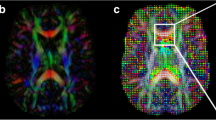Abstract
Introduction
This study aims to evaluate the differentiated effectiveness of MR diffusion tensor imaging (DTI) to postoperative recurrent glioma and radiation injury.
Methods
Conventional MRI and DTI examination were performed using Siemens 3.0 T MR System for patients with new contrast-enhancing lesions at the site of treated tumor with postoperative radiotherapy. The region of interest was manually drawn on ADC and FA maps at contrast-enhancing lesion area, peri-lesion edema, and the contra-lateral normal white matter. Then ADC and FA values were measured and, the ADC ratio and FA ratio were calculated. Twenty patients with recurrent tumor and 15 with radiation injury were confirmed by histopathologic examination (23 patients) and clinical imaging follow-up (12 patients), respectively. The mean ADC ratio and FA ratio were compared between the two lesion types.
Results
The mean ADC ratio at contrast-enhancing lesion area was significantly lower in patients with recurrent tumor (1.34 ± 0.15) compared to that with radiation injury (1.62 ± 0.17; P < 0.01). The mean FA ratio at contrast-enhancing lesion area was significantly higher in patients with recurrent tumor (0.45 ± 0.03) compared to that with radiation injury (0.32 ± 0.03; P < 0.01). Neither mean ADC ratio nor FA ratio in edema areas had statistical difference between the two groups. A recurrent tumor was suggested when either ADC ratio <1.65 or/and FA ratio >0.36 at contrast-enhancing lesion area according to the receiver operating characteristics curve analysis. Three patients with recurrent tumor and two with radiation injury were misclassified.
Conclusion
DTI is a valuable method to distinguish postoperative recurrent glioma and radiation injury.



Similar content being viewed by others
References
Fike JR, Sheline GE, Cann CE (1984) Radiation necrosis. Prog Exp Tumor Res 28:136–151
Castel JC, Caille JM (1989) Imaging of irradiated brain tumors. Value of magnetic resonance imaging. J Neuroradiol 16:81–132
Brandes AA, Franceschi E, Tosoni A (2008) MGMT promoter methylation status can predict the incidence and outcome of pseudoprogression after concomitant radiochemotherapy in newly diagnosed glioblastoma patients. J Clin Oncol 26:2192–2197
Tsien C, Galbán CJ, Chenevert TL (2010) Parametric response map as an imaging biomarker to distinguish progression from pseudoprogression in high-grade glioma. J Clin Oncol 28:2293–2299
Jain R, Scarpace LM, Ellika S (2010) Imaging response criteria for recurrent gliomas treated with bevacizumab: role of diffusion weighted imaging as an imaging biomarker. J neuro oncology 96:423–431
Cairncross JG, Pexman JHW, Rathbone MP (1985) Postoperative contrast enhancement in patients with brain tumor. Ann Neurol 17:570–575
Mullins ME, Barest GD, Schaefer PW (2005) Radiation necrosis versus glioma recurrence: conventional MR imaging clues to diagnosis. Am J Neuroradiol 26:1967–1972
Le Bihan D, Mangin JF, Poupon C (2001) Diffusion tensor imaging: concepts and applications. J Magn Reson Imaging 13:534–546
Mamata H, Mamata Y, Westin CF (2002) High-resolution line scan diffusion tensor MR imaging of white matter fiber tract anatomy. Am J Neuroradiol 23:67–75
Rock JP, Scarpace L, Hearshen D (2004) Associations among magnetic resonance spectroscopy, apparent diffusion coefficients, and image guided histopathology with special attention to radiation necrosis. Neurosurgery 54:1111–1119
Hein PA, Eskey CJ, Dunn JF (2004) Diffusion-weighted im aging in the follow-up of treated high-grade gliomas: tumor recurrence versus radiation injury. AJNR 25:201–209
Kitahara S, Nakasu S, Murata K (2005) Evaluation of treatmentinduced cerebral white matter injury by using diffusion-tensor MR imaging: initial experience. Am J Neuroradiol 26:2200–2206
Witwer BP, Moftakhar R, Hasan KM (2002) Diffusion tensor imaging of white matter tracts in patients with cerebral neoplasm. J Neurosurg 97:568–575
Asao C, Korogi Y, Kitajima M (2005) Diffusion-weighted imaging of radiation-induced brain injury for differentiation from tumor recurrence. AJNR Am J Neuroradiol 26:1455–1460
Biousse V, Newman NJ, Hunter SB (2003) Diffusion weighted imaging in radiation necrosis. J Neurol Neurosurg Psychiatry 74:382–384
Sundgren PC, Fan XY, Dong Q (2006) Differentiation of recurrent brain tumor versus radiation injury using diffusion tensor imaging in patients with new contrast-enhancing lesions. Magn Reson Imaging 24:1131–1142
New P (2001) Radiation injury to the nervous system. Curr Oppin Neurol 14:725–734
Valk PE, Dillon WP (1991) Radiation injury of the brain. Am J Neuroradiol 12:45–62
Mrugala MM, Kesari S, Ramakrishna N (2004) Therapy for recurrent malignant glioma in adults. Expert Rev Anticancer Ther 4:759–782
Fosting M, Albert FK, Sk K (1993) Extirpation of glioblastomas: MR and CT follow up of residual tumor and regrowth patterns. AJNR 14:77–81
Beppu T, Inoue T, Shibata Y (2003) Measurement of fractional anisotropy using diffusion tensor MRI in supratentorial astrocytic tumors. J Neurooncol 63:109–116
Sinha S, Bastin ME, Whittle IR (2002) Diffusion tensor imaging of high-grade cerebral gliomas. Am J Neuroradiol 23:520–527
Kashimura H, Inoue T, Beppu T (2007) Diffusion tensor imaging for differentiation of recurrent brain tumor and radiation necrosis after radiotherapy—three case reports. Clin Neurol Neurosurg 109:106–110
Acknowledgments
We thank Li Li and Sha Kong for coordinating the study, Ji-liang Zhang for preparation of figures, and Pei-hong Qi for the help with statistical analysis.
Conflict of interest statement
We declare that we have no conflict of interest.
Author information
Authors and Affiliations
Corresponding author
Rights and permissions
About this article
Cite this article
Xu, JL., Li, YL., Lian, JM. et al. Distinction between postoperative recurrent glioma and radiation injury using MR diffusion tensor imaging. Neuroradiology 52, 1193–1199 (2010). https://doi.org/10.1007/s00234-010-0731-4
Received:
Accepted:
Published:
Issue Date:
DOI: https://doi.org/10.1007/s00234-010-0731-4




